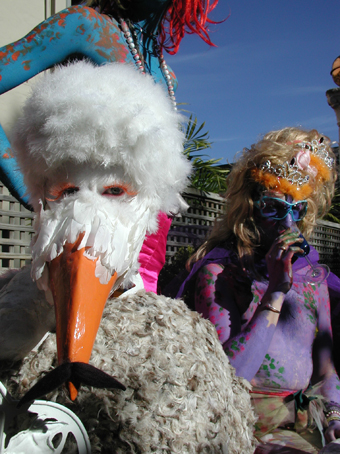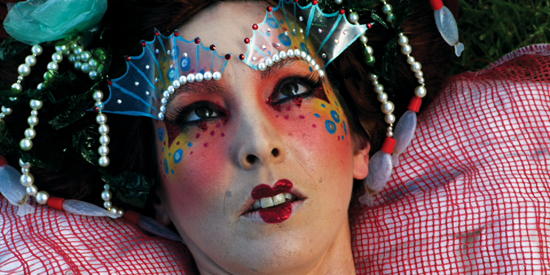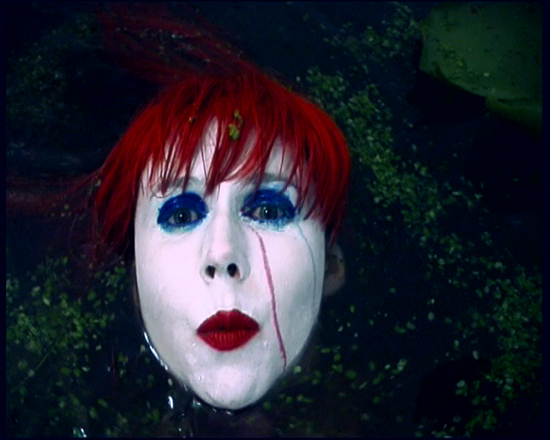Guest blogger Rebecca Conroy recalls Elena Knox‘s 2011 exhibition of video poetry staged in a bookshop and wonders if the exhibition hinted at an alternative to the white box…
Elena Knox, Fantasia of a Common Gull.
I must admit to being tired of the white cube. I feel indifferent to its clean surgical lines, and I am bored with the attention seeking banality which the white wall occasions for its art-seeking-audience. So an invitation to a retrospective exhibition of video poetry at a bookshop presented a refreshing break from the routine.
Fleshed Out presented a decade of solo and collaborative sound/text/video work by Sydney based interdisciplinary artist Elena Knox. Operating also as Lull Studios (a collaborative duo with partner Lindsay Webb), the artist has selected these works to mark a turning point in her career, reflecting on a body of work that drew together her most exemplary experiments with text sound and video, as she slightly adjusts herself for the role of PhD candidate at the College of Fine Arts (COFA) in Sydney.
But really, what is expected from an exhibition of video poetry? What is a video poem? Is it a short film of poetic resonance; words filmed as moving images in a poetic sequence? Or is video poetry a particular form of video art – using text as the basis for screen based experimentation? With Fleshed Out we could refer to a unifying element uses the grammar and punctuation of spoken and performed words as an organising principle in the creation of short digital video works.
Knox’s interdisciplinary approach (which moves fluidly across performance, writing, sound and design) demonstrates how poetry – a normally singularly conceived practice, and at times confessional and solitary pursuit – is opened up as a collaborative platform. Work/Flow (2011) portrays the solitary poet at his machine, whose words appear on the screen briefly as they are tapped out on paper, pausing for a moment to allow the viewer to digest them before sliding out of the typewriter directly into a paper shredder below. The industrial production and metronome pulse of the type-machine, and staccato effects of each letter embedded into paper, is violently reversed with the sudden automated finality of the shredder.
Elena Knox, Spin.
Spin (2011) is a lush 5 channel colour synchronized video installation which appears at the back of the bookstore in a cross/flag formation. The centre panel, also the largest screen, features performer Lian Loke undergoing the elaborate traditional Japanese practice of nyotaimori or “body sushi”. The whole work, which also stars a tragically beautiful passionfruit coral trout stranded inland, is a meditation on overconsumption, and its correlations with the depletion of fish populations in the world’s oceans. On an adjacent screen, the words of a poem are literally formed out of sushi on a bed of rice. As the geisha is consumed, her body moves and writhes, in rhythm with the coral trout until in the final scene she reappears on a cliff, lying flat, her body parallel to the ocean horizon. Elegantly conflating the fate of the woman as fish with the fish out of water, she quietly slips out of view and presumably into the ocean.
Elena Knox, Spin.
Earlier works Wet (2004) and Fantasia of a Common Gull (2007) indicate the beginning experimentation with text and image – use of direct camera address to deliver text in Wet, while subtitles in Fantasia mimic the karaoke display which forms a subtext for the ridiculously queer poolside action of a common gull caught between three sensational looking transvestite mermaids.
Luscious, alluring, seductive, and telltale, the stories are snapshots rendered in comic absurdist and haunting tones. In Knox’s work the visual is visceral much like the onomatopoeia which is characteristic of her performative text; speech acts as movement and sounds overlay and supersaturate each other. And particularly where Paul Warren’s camera work has masterfully captured breathing space, these visually lush sequences resonate even louder.
While Knox remains author of the texts, the video works also draw strength from her many generous collaborators whose playfulness and aesthetics respond excellently to the compositions. In this way, the artist opens up poetry to collaboration, in both its creation/making and in the act of experiencing the works, as the bookstore invites discovery and exchange.
Browsing the book aisles to seek out each of the eleven video works was a curiosity in itself; discovering them installed or rather intertextually woven into the narrative logic of the bookshelves and inbetween spaces. Not one to resist the temptation of cheeky wordplay, Knox has placed each of small screens alongside particular book titles whose narratives point to other possible meanings in a kind of improvised semiotic spiraling outwards. On a parallel shelf, Angela Carter‘s text Wicked Women hovered over Tom Rivard‘s performance of a flamboyant hopelessly contrived real estate baron leering at Knox as she performed a homewrecking on a displaced Silk Road – Piñata (2009).
Adopting the bookstore as exhibition space, I cannot help reading it as a metaphor (and bad pun) for the incursion of the digital into the printed domain. While the battles around intellectual property and pirating continue to rage, increasingly complicated notions of authorship are expanded as cognitive capitalism gains hegemony. Also present in this location is the slippage between consumer and retail environments and the seeking of experiential economies of pleasure, which the pop up gallery phenomenon best exemplifies.
A loose net would cast this as a retrospective of ‘expanded poetry’, previously circulated as individual works predominately in festival formats (Athens Video Art Festival, Akademie der Künste Berlin, Sydney Underground Film Festival, Melbourne Writers Festival, among others). There is nothing in these works that would make them ill-fitted to a white cube; however the decision to frame the collection within a bookshop adds to the viewing experience in a way that the white walls may have only rendered them lonely.
Despite the richness and many densely layered compositions, in a blank space devoid of additional softening fabrics, colours and sounds, perhaps these works would merely echo or bounce. Surrounded by a greater cacophony of other words and ‘texts’, Knox’s work is rightly confident, drawing us in, making us curious, of both the quirky and the sublime.





Pingback: Another fine review if we say so ourselves | Lull Studios News